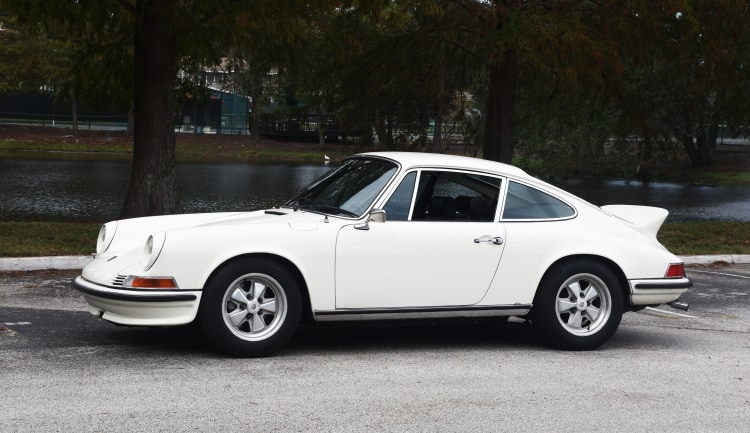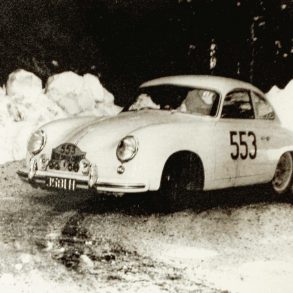You may recognize Bill Warner as the Founder and Chairman of the Amelia Island Concours d’Elegance, held each March on that charming resort island in Florida.
This is true, but Mr. Warner is a man of so many more facets and dimensions: he’s a husband, father, and grandfather. A Jacksonville area businessman. A charitable philanthropist. Military veteran and reservist. An accomplished sports car racer of considerable talent and an enthusiastic car collector. Noted motorsport photographer and author. At a recent Concours dinner, he was introduced as “enthusiastic,” “benevolent,” “genuine,” and “magnanimous”- True descriptors all.


In November of 1971, Bill did what every clear-thinking, married, father of one with a pregnant wife would do – he cashed in his chips and bought a brand new Porsche 911 – for $7900.

“Like everyone else, I really wanted a 911S,” Warner wistfully recalls, “but an S was nine grand, and who could afford that?” So he “settled” for a modestly yet meaningfully equipped carbureted, 140 bhp ’71 911T coupe.
The white over hound’s-tooth and black coupe came with chrome steel 912 style wheels and hubcaps, plus air conditioning, and that was about it.

Warner justified this purchase for his growing family:
“I figured I’d do most of the driving, wife Jane would sit in the passenger seat, my son would fit in the back, and the new baby and baby seat would also fit fine in the back.”
Great plan – until they learned that Mrs. Warner was carrying twins. Bill got to keep his ‘sports car toy,’ and Mrs. Warner had a new Buick station wagon within a few weeks.

The 911 was intended as Warner’s everyday driver, which it was for several years. He traveled extensively around the South as a salesman in the water system and filtration business, putting about 30,000 miles a year on the car in the first three years he owned it.
He kept it primarily original but ultimately elected to build a larger, supposedly hotter engine for it: the original 2.2 was replaced with a built up 2.7.

Bill, being a sports car and racing enthusiast and photographer, living and working in and around Jacksonville, Florida, found himself in the middle of the racing scene in the mid-1970s; not far from either the Daytona or Sebring raceways. Guys like Hurley Haywood and Peter Gregg became his friends.
He went go-karting one night with Haywood, Gregg, and Car and Driver magazine Editor Brock Yates, one of the founding fathers of the (even by then) legendary Cannonball Baker Sea-to-Shining-Sea Memorial Trophy Dash underground unofficial cross country race.

Yates and Dan Gurney, aboard a Ferrari 365/GTB-4 Daytona, won the first Cannonball in 1972. The event was contested again in the fall of 1973, this time with Yates in his own modified Dodge Challenger, finished second.
During the Warner/Gregg/Haywood/Yates karting Grand Prix session, Yates announced that he intended to run another Cannonball.
The rules were relatively straightforward in concept if not always execution: get yourself, your companions, and your vehicle of choice from the famous Red Ball Garage in Manhattan, New York City, to the Portofino Inn hotel in Redondo Beach, California, as quickly as you can, by any route you choose.
Vehicle choice was absolutely open, and over time, has run the gamut from MGBs to surfer style vans (packing jury rigged massive fuel tanks) and motorhomes, to Cadillac limos to Ferraris.
The magic number to accomplish all this seemed to be 36 hours, a time that was ultimately met and beaten often. The other unwritten rule was not to injure or kill yourself or anyone else along the trail.

What measures needed to avoid America’s Highway Patrol officers was up to each team.
Most teams left the Red Ball in the middle of the night to avoid NYC’s choking commuter traffic, with the intent to arrive midafternoon in SoCal a day and a half later with the same goal in mind.
Rather than a barrage of screaming cars all blasting into Manhattan at the same time, the vehicles pulsed out at staggered intervals, and the team that made it across America in the least total elapsed time was the winner.
As the events were run in mid-November, some careful route planning was required in order to avoid snowy weather, rain, and other conditionally mandated road closures.
Google nav systems in those days consisted of a paper folding map of the US Highway system, a yellow marker, and a flashlight.
Drivers would usually alternate every few hours so the other could attempt to catch a little sleep. Fuel and pit stops needed to be quick and efficient. Shopping bags full of peanut butter sandwiches, candy bars, Vitamin C tablets, and Thermoses filled with coffee stood for provisions. No internet and no cellphones – although Citizen’s Band (CB) Radios and police scanners were standard.

Over time, there were all-female teams, semi-ringer ProAm teams consisting of varying numbers of enthusiast participants, and heavy hitter racers (kind of like, oh, Dan Gurney and the late Tony Adamowicz).
With each year, fast cars have proven successful, but even more so are teams that run smart, “fast, steady” speeds, avoid the law and mechanical breakdowns, and get better than awful fuel mileage.
Warner, being a racer himself and a general lover of travel and adventure, thought this all sounded like fun, and Yates opened the door. Bill had never been to California and thought this a novel way to get there, so he steeled himself to enter the third, 1974 running of the Cannonball.
What to drive: the answer was as obvious and close as his driveway, his trusty 911, of course.

Warner picked up a 31-gallon plastic “endurance” spec fuel tank (from the George Stone/George Drolsom Carrera racer) for the frunk of his 911 – figuring this would up his highway fuel range to as much as 600 miles per tank. He added a Carrera style rear ducktail and a Porsche Motorsport front spoiler, plus a set of ancillary driving lights.
A lot of thought went into the wheel and tire selection, Bill ultimately decided to stick with his stock steelies and relatively narrow tires; for in the Cannonball, high-speed cornering prowess isn’t a high priority, but straight-line smoothness, a lower aero profile, and less drag contributed to an easier drive and maximized fuel economy.
They bolted in a CB radio and a “Fuzzbuster” radar detector, which likely detected more airports than Highway Patrol cruisers. The car also ran a quad-tipped sport exhaust at the time. An oil change and a full tank of fuel, and the 911 was declared ready.
His driving partner was to be Tom Nehl, an experienced racer and IMSA veteran; Warner was initially thrilled at this pairing until Nehl told Bill that Bill must drive all the nighttime stints since he, Nehl, had terrible night vision and couldn’t drive fast at night. Oy — What could possibly go wrong?

Warner and Nehl elected to take a Southern route rather than the more northerly route many of the Cannonballers chose, hearing that the Highway Patrol in the northern mid-western states were alerted about the race and was “waiting for them.”
The full results of Cannonball III are well chronicled in the August 1975 issue of Car and Driver magazine, and also in Yates’ excellent 2003 book about the whole grand affair, entitled simply Cannonball! So we won’t recount the entire sordid experience here, but the little white Porsche finished in 14th place, completing the entire near 3000-mile romp in 41 hours, 35 minutes averaging 69.9 miles per hour (including time down for fuel and pitstops).

That speed might not sound scintillating given Yates and Gurney’s run in their howling Daytona, which often topped 150mph and occasionally pushed 170.
Team White Porsche’s strategy was to let the faster cars run the rabbit position, hopefully attracting most of the law enforcement attention and mechanical setbacks. Although when conditions allowed, they did crank up the heat to 100-130 mph in order to make up some time, but 85 mph was the most consistent average.

Warner recalls the 911 running smooth and trouble-free the entire way, often exceeding 500 miles per tank of fuel.
He also said that “we underestimated the difficulty of the Cannonball.” Their smooth, relatively modest pace wasn’t met with the arrest rate they’d projected for some of the faster runners, hence the lower mid-pack finish in spite of the modest speeds. The last place car finished 18th.
The overall winner was a Ferrari 246 Dino that set a new event record of 35 hours, 53 minutes averaging 81.0 mph.

Apart from the driving lights and the more recent swap to the set of Fuchs S/T wheels now on the car, Warner’s 911 appears much as it did for its Cannonball run.
The Brumos built 2.7 lasted and ran well for 30 years, the hound’s-tooth seat inserts have been replaced once, and the car’s had one repaint in its original color. Save those seat inserts; the interior is absolutely factory original.

Bill chuckles at the notion of the rectangular outside rearview mirror, in that it’s regularly postulated that “’71 911s have round mirrors, and only for ’72 did they get the rectangular piece.”
His car was produced in September of 1971, so it’s not a stretch to imagine that by then, ’72 spec pieces had begun arriving on the production line.
After 46 years of ownership and around 130,000 miles, the car was due for a refresh, which it got in early 2017. So the previous 2.7 came out in favor of a carefully built and prepared 2.5 running “big heads, and 46mm Webers plus a stock, single exhaust system.”

Warner notes that the new engine is good for 180-200 horsepower and that it’s a lot stronger than was the previous 2.7 or the original 2.2. The new 2.5 liter motor with S cams and 46mm Webers was built by David Glenn, Flagler Beach, Florida.
The aforementioned S/T wheels came off of one of the late Peter Gregg’s cars. This refresh also included new front and rear anti-roll bars, plus a longer 5th gear to help keep the noise and revs down for highway cruising.
Its break-in cruise included a road trip, still with no longer pregnant wife Jane but no baby seats aboard, around New York, Connecticut, and Pennsylvania. Warner says it’s the car he’ll never sell and that it’s already earmarked for his son to assume ownership duties when that time comes.
Brock Yates — magazine writer, book author, movie producer, and few times SCCA TransAm competitor — the original Cannonballer himself, nicknamed The Assassin due to his direct, to the point and often acerbic writing style, passed away October 5, 2016.
Photos courtesy Matt Stone, Bill Warner, and the Amelia Island Concours d’Elegance











Great story Matt ! I don’t recall the Dino being an overall winner. The blue Daytona is still in somebody’s collection in the Pac NW.
Jack May and Rick Kline won in 1975 in Jack’s Dino, which he still owns. Was just with him yesterday.